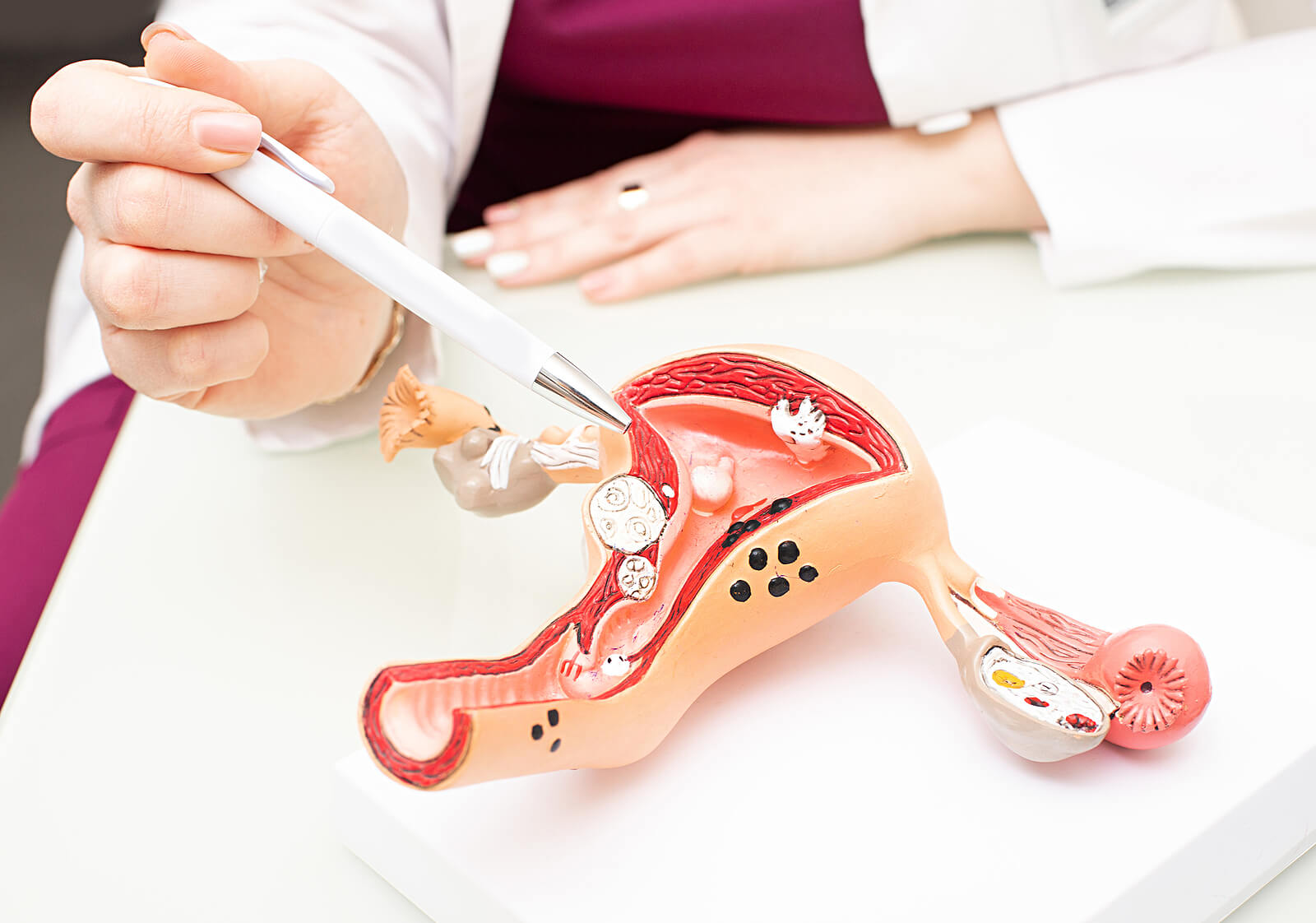Endometriosis in Adolescents: How to Identify It and What to Do About It


Written and verified by the nurse Leidy Mora Molina
Every day, it’s more and more common to hear of cases of endometriosis in adolescents, a chronic disease that affects the reproductive organs and produces annoying and disabling symptoms. In fact, it’s one of the causes of school absenteeism in adolescence.
In addition to the discomfort, endometriosis can produce some complications when it’s not treated in time, such as fertility problems. Learn all about this gynecological disease in this article.
What is endometriosis?
Endometriosis is a disease that causes the benign growth of endometrial tissue outside the uterus. This structure is the one that covers the uterine muscle and part of it is shed month after month in the form of menstrual bleeding.
But when the endometrium grows in areas where it shouldn’t (such as ovaries, fallopian tubes, or abdominal cavity), its proliferation causes pain and irritation in these organs. As this tissue responds to the hormonal changes of the menstrual cycle, at the time of the menstrual period, it becomes inflamed and the discomfort increases more than normal.
According to the World Health Organization, endometriosis affects approximately 10% of women and girls of reproductive age, which translates into some 190 million people worldwide.
Unfortunately, endometriosis is a chronic disease that can’t be cured. And while its early diagnosis can prevent several complications, it’s not always easy to achieve due to the variability of its manifestations.

Endometriosis in adolescence
Endometriosis can appear from the beginning of a woman’s fertile years, but there are many factors that make early detection difficult.
On the one hand, this happens because girls don’t always feel confident enough to talk about these issues with their parents or doctor. On the other hand, the symptoms they manifest, such as the intensity of pain, may not be given enough importance due to the emotional factors of adolescence.
Therefore, the chances of reaching a timely diagnosis are reduced and this ends up affecting the quality of life of young women. It’s believed that at least 2 out of 3 adolescents suffering from chronic pelvic pain or severe menstrual pain have endometriosis.
You may be interested in: Gynecological Osteopathy for Menstrual Cramps
How to identify endometriosis in adolescence
Endometriosis is a disease with very varied manifestations, among which the following stand out:
- Dysmenorrhea: Moderate to severe menstrual pain, which may occur at any time during the menstrual cycle
- Chronic pelvic pain
- Heavy menstrual bleeding with clots
- Irregular menstrual cycles
- Dyspareunia (pain during sexual intercourse)
- Intestinal transit disorders (constipation or diarrhea)
- Dysuria (painful urination) or painful defecation
- Nausea
- Depression and anxiety
- Chronic fatigue
Certainly, the symptomatology described can affect the daily life of adolescent girls. It’s been observed that those suffering from this disease have higher absenteeism from school, in addition to low participation in sports or extracurricular activities.
However, the symptoms of endometriosis aren’t always so clear. Some adolescents have such mild symptomatology that they’re not aware of their condition, and cases of asymptomatic endometriosis have even been described.
One of the biggest problems of this disease is the associated complications. Due to the invasion of endometrial tissue into the pelvis or other genital organs, endometriosis can cause infertility if not controlled.
Diagnosis of endometriosis in adolescence
To detect that it’s indeed endometriosis and not another pelvic condition, gynecologists rely on the adolescent’s medical history, physical examination, and pelvic ultrasound. The latter can detect the presence of cysts or scars caused by this disease.
During adolescence, the diagnosis of endometriosis can be difficult, not only because of the variability of the symptoms, but also because of the technical difficulties in visualizing the lesions by ultrasound. In adult women, these are usually much sharper and more suggestive of the condition.
Finally, to make a diagnosis of certainty of the disease, it’s important to perform an exploratory laparoscopy. In this minor surgery, the physician makes a small incision in the woman’s abdomen and inserts a thin tube with a camera to visualize the area. He then proceeds to look for endometrial tissue outside the uterus and if found, proceeds to take a sample for biopsy.

The treatment of endometriosis in adolescence
Although this disease has no cure, its symptoms are treatable through pharmacological or surgical treatment.
First, the gynecologist will prescribe analgesic drugs to reduce pain. In addition, hormonal treatment with oral contraceptives or progesterone is usually indicated to reduce menstrual bleeding and relieve period pains. It’s also important to adopt a healthier diet and lifestyle.
If after 6 months of this treatment, the symptomatology persists, the next step will be surgical treatment to remove the lesions, adhesions, and scar tissue outside the uterus. However, some time later, the disease may reappear.
Endometriosis in adolescence: What to do?
Endometriosis is the main cause of dysmenorrhea in adolescents, so it’s important to take into account the manifestations of pain in adolescents during their menstruation. As we’ve mentioned, early diagnosis improves the quality of life of women and avoids future complications.
Finally, it’s important for parents to be aware of the appearance of these symptoms and to provide support and information to their daughters about this type of disease. Especially if they’ve presented menstrual irregularities since their development.
Every day, it’s more and more common to hear of cases of endometriosis in adolescents, a chronic disease that affects the reproductive organs and produces annoying and disabling symptoms. In fact, it’s one of the causes of school absenteeism in adolescence.
In addition to the discomfort, endometriosis can produce some complications when it’s not treated in time, such as fertility problems. Learn all about this gynecological disease in this article.
What is endometriosis?
Endometriosis is a disease that causes the benign growth of endometrial tissue outside the uterus. This structure is the one that covers the uterine muscle and part of it is shed month after month in the form of menstrual bleeding.
But when the endometrium grows in areas where it shouldn’t (such as ovaries, fallopian tubes, or abdominal cavity), its proliferation causes pain and irritation in these organs. As this tissue responds to the hormonal changes of the menstrual cycle, at the time of the menstrual period, it becomes inflamed and the discomfort increases more than normal.
According to the World Health Organization, endometriosis affects approximately 10% of women and girls of reproductive age, which translates into some 190 million people worldwide.
Unfortunately, endometriosis is a chronic disease that can’t be cured. And while its early diagnosis can prevent several complications, it’s not always easy to achieve due to the variability of its manifestations.

Endometriosis in adolescence
Endometriosis can appear from the beginning of a woman’s fertile years, but there are many factors that make early detection difficult.
On the one hand, this happens because girls don’t always feel confident enough to talk about these issues with their parents or doctor. On the other hand, the symptoms they manifest, such as the intensity of pain, may not be given enough importance due to the emotional factors of adolescence.
Therefore, the chances of reaching a timely diagnosis are reduced and this ends up affecting the quality of life of young women. It’s believed that at least 2 out of 3 adolescents suffering from chronic pelvic pain or severe menstrual pain have endometriosis.
You may be interested in: Gynecological Osteopathy for Menstrual Cramps
How to identify endometriosis in adolescence
Endometriosis is a disease with very varied manifestations, among which the following stand out:
- Dysmenorrhea: Moderate to severe menstrual pain, which may occur at any time during the menstrual cycle
- Chronic pelvic pain
- Heavy menstrual bleeding with clots
- Irregular menstrual cycles
- Dyspareunia (pain during sexual intercourse)
- Intestinal transit disorders (constipation or diarrhea)
- Dysuria (painful urination) or painful defecation
- Nausea
- Depression and anxiety
- Chronic fatigue
Certainly, the symptomatology described can affect the daily life of adolescent girls. It’s been observed that those suffering from this disease have higher absenteeism from school, in addition to low participation in sports or extracurricular activities.
However, the symptoms of endometriosis aren’t always so clear. Some adolescents have such mild symptomatology that they’re not aware of their condition, and cases of asymptomatic endometriosis have even been described.
One of the biggest problems of this disease is the associated complications. Due to the invasion of endometrial tissue into the pelvis or other genital organs, endometriosis can cause infertility if not controlled.
Diagnosis of endometriosis in adolescence
To detect that it’s indeed endometriosis and not another pelvic condition, gynecologists rely on the adolescent’s medical history, physical examination, and pelvic ultrasound. The latter can detect the presence of cysts or scars caused by this disease.
During adolescence, the diagnosis of endometriosis can be difficult, not only because of the variability of the symptoms, but also because of the technical difficulties in visualizing the lesions by ultrasound. In adult women, these are usually much sharper and more suggestive of the condition.
Finally, to make a diagnosis of certainty of the disease, it’s important to perform an exploratory laparoscopy. In this minor surgery, the physician makes a small incision in the woman’s abdomen and inserts a thin tube with a camera to visualize the area. He then proceeds to look for endometrial tissue outside the uterus and if found, proceeds to take a sample for biopsy.

The treatment of endometriosis in adolescence
Although this disease has no cure, its symptoms are treatable through pharmacological or surgical treatment.
First, the gynecologist will prescribe analgesic drugs to reduce pain. In addition, hormonal treatment with oral contraceptives or progesterone is usually indicated to reduce menstrual bleeding and relieve period pains. It’s also important to adopt a healthier diet and lifestyle.
If after 6 months of this treatment, the symptomatology persists, the next step will be surgical treatment to remove the lesions, adhesions, and scar tissue outside the uterus. However, some time later, the disease may reappear.
Endometriosis in adolescence: What to do?
Endometriosis is the main cause of dysmenorrhea in adolescents, so it’s important to take into account the manifestations of pain in adolescents during their menstruation. As we’ve mentioned, early diagnosis improves the quality of life of women and avoids future complications.
Finally, it’s important for parents to be aware of the appearance of these symptoms and to provide support and information to their daughters about this type of disease. Especially if they’ve presented menstrual irregularities since their development.
All cited sources were thoroughly reviewed by our team to ensure their quality, reliability, currency, and validity. The bibliography of this article was considered reliable and of academic or scientific accuracy.
- Franco, M. (2020). Dismenorrea y endometriosis en la adolescente. Sociedad de obstetricia y ginecología de la provincia de Buenos Aires. Recuperado de: http://www.sogba.org.ar/index.php/informacion-cientifica/sogba-interior/306-dismenorrea-y-endometriosis-en-la-adolescente
- Laufer, M (2007). Endometriosis en adolescentes: avances en el tratamiento médico y quirúrgico. Sociedad Chilena de Obstetricia. V Congreso de Obstetricia, Ginecología Infantil y Adolescencia. Recuperado de: https://www.medwave.cl/link.cgi/Medwave/PuestaDia/Congresos/1261
- Organización mundial de la salud OMS (2022). Endometriosis. Recuperado de: https://www.who.int/es/news-room/fact-sheets/detail/endometriosis
- Zuccardi, L. (2007). Endometriosis en la etapa infanto-juvenil: presentación de nueve casos en un hospital pediátrico. Archivos argentinos de pediatría Vol. 105 N°4. Recuperado de: http://www.scielo.org.ar/scielo.php?script=sci_arttext&pid=s0325-00752007000400008#:~:text=Las%20adolescentes%20con%20endometriosis%20frecuentemente,alg%C3%BAn%20tipo%20de%20dolor%20p%C3%A9lvico.&text=Este%20%C3%BAltimo%20puede%20tener%20diferentes,gastrointestinal%20o%20urinario%2C%20y%20dispareunia.
This text is provided for informational purposes only and does not replace consultation with a professional. If in doubt, consult your specialist.








